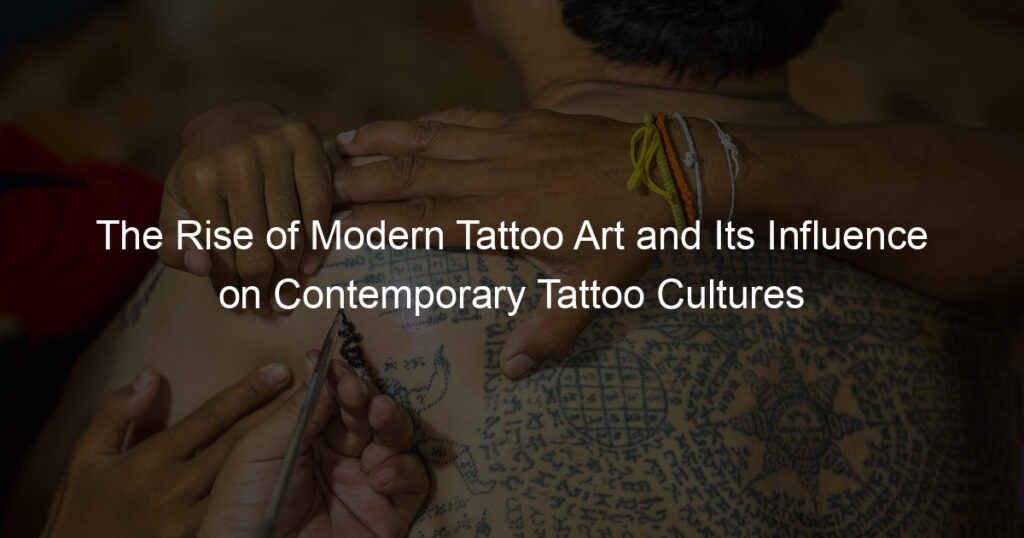The rise of modern tattoo art has been a game-changer for the contemporary tattoo scene. Artists like Scott Campbell, GRIME, and Jason Leandro have taken tattooing to new heights with their unique styles and cutting-edge techniques.
This new wave of tattoo artists is having a major impact on current tattoo cultures around the world.
From Los Angeles to Berlin, more and more people are getting tattoos that are pushing the boundaries of what a tattoo can be. If you’re thinking about getting inked up, these modern tattoo artists are worth checking out!
What is the significance of tattoos in our culture?
Tattooing is an ancient form of self-expression. It has played a significant role in many cultures dating back centuries, and its popularity is spreading around the globe.
For many people, getting a tattoo symbolizes their beliefs, values, and memories; it is a physical representation of their emotions and desires.
Whether it is used as an artistic expression or to mark a particular moment in time, by getting inked, people are allowing outsiders to enter their private world and connect with them on a deeper level.
Furthermore, tattoos can also be a source of source and healing during difficult times. By honoring their stories through body art, individuals can own their narrative, stand up for what they believe in—and ultimately create an identity that conveys both pride and power.
Cultures with tattoo traditions
Tattooing is a practice with deep historical roots, especially among certain cultures whose tattoos are used to serve purposes beyond simply decoration. Ancient Egyptians, Celts, and Polynesians were some of the earliest cultures known to use tattooing in their society.
They filled their bodies with symbols related to their belief systems and way of life, using the tattoos for protection or for marking special occasions such as coming-of-age events.
Over time, other cultures have adopted these traditions and put their modern twists on them – from tattooed Maori facial designs in New Zealand to intricate dot work inspired by Tibetan mandala art.
Whether it’s a cultural practice steeped in traditional roots or an individual style designed specifically for oneself, tattoos can be seen as a form of expression reflecting personal stories and journeys throughout life.
When did modern tattoos become popular?
It is hard to trace the exact roots of modern tattooing, in part because archeologists have mostly found ancient examples with natural pigments that are difficult to discern after thousands of years.
But what is known for sure is that modern tattoos–the kind you get from a professional artist with electric needles and colorful ink–have been popular since at least the 1950s, when sailors and servicemen began coming home from World War II with their fresh tattoos.
Since then, tattooing has become an art form and even a form of personal expression that has grown in complexity and acceptance over the decades.
Today, things have come a long way from where they used to be–you no longer need to sneak away to hidden alleyways to get body art, but can instead choose an experienced professional artist or shop right in your neighborhood.
How is a modern-day tattoo different from a traditional tattoo?
Modern-day tattoos have come a long way from the traditional style of tattoos. The most notable difference is that modern-day tattoos are done through electrical machines, as opposed to the hand-tapping and hand-poking techniques used in traditional tattoos.
This has allowed for an exponential increase in detail and quality, as well as an almost limitless choice of colors and shades. It also results in faster application, allowing for more intricate designs which take less time to complete.
Furthermore, due to advances in the field of design, modern-day tattoos stray away from the symbolic images found in traditional tattoos, increasingly featuring personal stories and meaningful quotes instead.
What are the meaning and significance of tattoos during modern times?
Tattoos have been used by many different cultures and people to mark their identity. In modern times, tattoos can be used to express personality and affiliation.
From simple symbols of luck to powerful messages about a person’s life journey, tattoos are a way to show pride in one’s identity or heritage.
They can also signify important milestones in a person’s life, such as graduations, marriages, births, or any other turning point that deserves honor or celebration.
Additionally, compared to past times, tattooing has advanced significantly in terms of its artistry and intricacy. This means that modern-day tattoos can now also highly range from individually unique to create abstract works of art which express far more than just personal beliefs and ambitions.
All this helps explain why the popularity of tattoos is rising rapidly in the modern age: they make powerful statements about personal values, life paths, and individuality without requiring verbal communication.
Wrapping Things Up
The rise of modern tattoo art has had a profound influence on contemporary tattoo cultures. This can be seen in the way that artists are reinterpreting traditional tattoo designs, and in the way that new tattoos are being designed to reflect modern trends.
Tattoo culture is evolving and growing more complex every day, and it shows no signs of slowing down. As we move into the future, it will be interesting to see how these changes continue to shape the world of body art.














